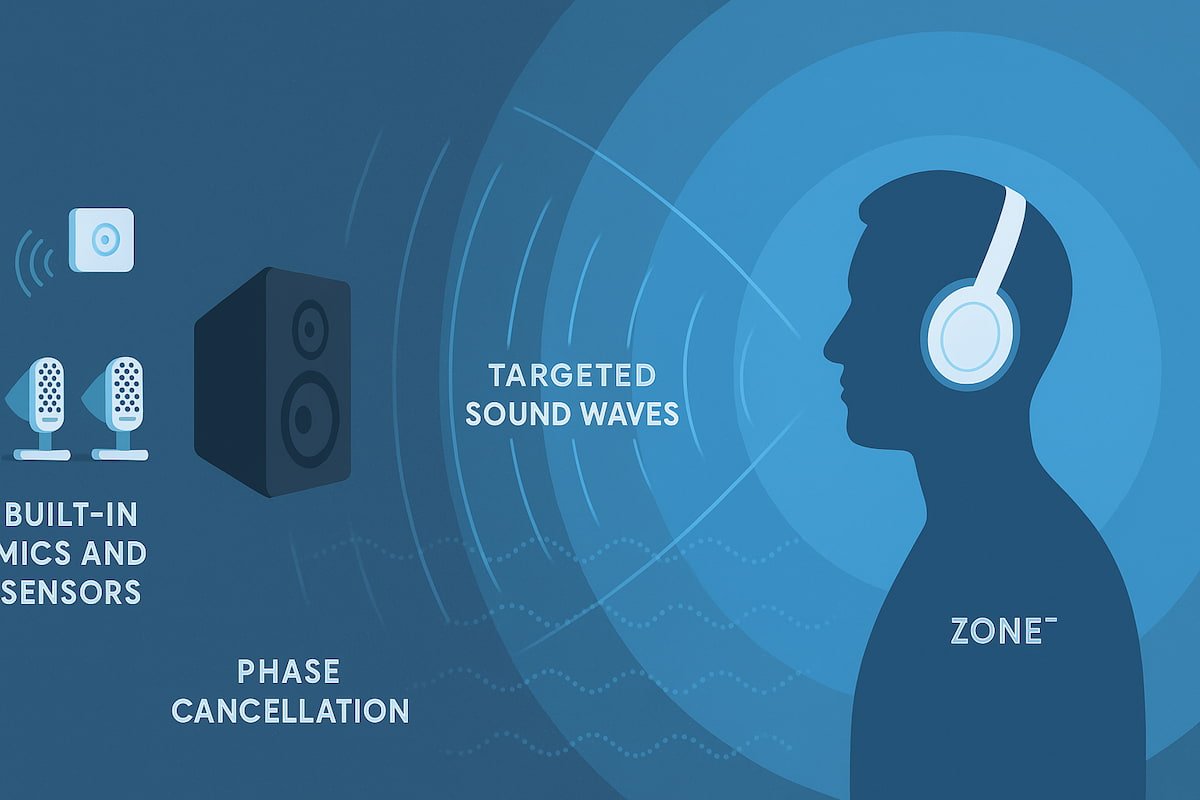Imagine blasting your favorite show at full volume while someone just a few feet away enjoys a podcast—without either of you hearing the other. Sounds like science fiction? Thanks to Personalized Sound Zone (PSZ) technology, it’s quickly becoming a real-world possibility.
PSZ tech creates individual “sound bubbles,” so multiple people in the same room can listen to completely different things without using headphones. Whether you’re in a car, a shared office, or your living room, PSZ gives you amazing control over what you hear—offering privacy, customization, and an all-around better sound experience.
Table of Contents
How Does PSZ Technology Work?
At its core, PSZ uses a mix of advanced acoustics and clever engineering to send sound exactly where it’s needed.

Here’s how it all comes together:
- Targeted Sound Waves: Using a method called beamforming, audio is directed into specific zones instead of spreading all over the place.
- Noise Blocking with Phase Cancellation: It also sends out inverted sound waves to cancel out audio outside the intended area—so the sound doesn’t spill over.
- Smart Environmental Tuning: Built-in mics and sensors analyze the room in real time, tweaking the sound delivery for the best possible effect.
The result? You hear your content clearly inside your “zone,” while everything stays quiet for everyone else nearby.
Real-World Applications of PSZ Technology
PSZ technology isn’t just a futuristic concept—it’s already finding its way into everyday life across multiple industries.

Here’s how it’s making a difference:
In the Car: A Better Drive for Everyone
Ever been on a road trip where everyone wants to listen to something different? With PSZ, that’s no longer a problem. This tech creates private audio zones for each seat, so:
- Dad can listen to a podcast
- Mom can enjoy her playlist
- The kids can watch a movie
— and no one needs headphones.
Plus, it enhances safety. Drivers can get navigation cues or collision alerts directly—without distracting passengers.
At Home: Entertainment Without Arguments
Tired of fighting over the remote or volume levels? PSZ tech makes multi-user households more peaceful.
- In the Living Room: One person can watch a movie, another can chill with music, and they won’t interrupt each other.
- In Gaming Setups: Gamers can dive into their favorite titles with immersive sound—without bothering anyone else in the room.
Devices like the NWM ONE Wireless Open-Ear Headphones use PSZ tech to deliver clear, rich sound while keeping your ears open to your surroundings. It’s the perfect blend of personal audio and shared space awareness.
In the Office: Focus Without Isolation
Open-plan offices can be noisy and distracting. PSZ helps by creating focused sound zones:
- Take private calls without disturbing others
- Listen to ambient or focus-enhancing sounds to stay in the zone
- Cut down on background chatter for a calmer, more productive workspace
With smart chips like the QCC3091, wireless audio devices are becoming even more powerful. (Curious about what that chip does? Check out our post on it!)
The Benefits of PSZ Technology
Enhanced Privacy
One of the biggest perks of PSZ tech is that it gives you your own private listening space—even when you’re surrounded by other people.
- For Individuals: Whether you’re taking a confidential Zoom call or just watching your favorite show, you won’t disturb others—and they won’t overhear your audio.
- In Shared Spaces: It’s a game-changer for open-plan offices and busy homes, where everyone wants their own sound bubble.
More Comfortable Listening
Let’s be honest—wearing headphones for hours can get uncomfortable, especially if they’re bulky or press on your ears.
- No More Headphones Needed: PSZ delivers clear, personal audio without the need to wear anything.
- Better for Long Sessions: Whether it’s a podcast binge or a movie marathon, you can enjoy it all without ear fatigue.
Energy Efficient
PSZ doesn’t just sound good—it’s smarter about power, too.
- Lower Volume, Same Quality: Since the sound is precisely directed, devices don’t need to crank up the volume.
- Longer-Lasting Devices: Less strain on speakers means fewer breakdowns and replacements—saving money and reducing waste.
Made for Multitasking
PSZ is perfect for households and classrooms where everyone wants to do something different at the same time.
- In Education: Teachers can share different audio tracks with small groups without needing separate rooms.
- At Home: You can watch TV, someone else can play a game, and someone else can chill with music—all in one space, no interruptions.
Challenges of PSZ Technology
Like any new tech, PSZ isn’t without its hurdles:
- High Costs: The equipment and development behind PSZ tech are still pricey.
- Tricky Setup: Installing it properly takes some expertise and careful tuning.
- Room Limitations: Oddly shaped spaces or bad acoustics can mess with how well the sound zones work.
But here’s the good news: as the technology matures and becomes more mainstream, these issues are likely to fade. Just like Bluetooth and noise-canceling tech, PSZ could soon be a standard feature in our devices.
PSZ Technology vs. Traditional Audio Systems
Let’s quickly see how PSZ stacks up against the old-school audio approach:
| Feature | PSZ Technology | Traditional Audio Systems |
|---|---|---|
| Privacy | Excellent – sound stays in your zone | Limited – sound spreads freely |
| Energy Efficiency | High – uses focused sound projection | Moderate – relies on overall volume |
| Device Requirement | Minimal – no need for headphones | Needs headphones or speakers |
| Cost | High – advanced and still evolving | Lower – widely available and simpler |
The Future of PSZ Technology
PSZ is more than a cool innovation—it has the potential to redefine how we experience sound across different industries. Here’s where it could be headed next:
- Smart Homes: Seamless integration with IoT devices could let you create fully personalized sound zones in your living room, kitchen, or even your shower.
- Healthcare: Hospitals could deliver calming or informative audio to specific patients while keeping the room quiet overall.
- Education: Imagine classrooms where students each receive tailored lessons without wearing headphones or disturbing others.
Companies like NTT, Harman, and Bose are at the forefront, pushing boundaries to make this tech more practical and widely accessible.
Final Thoughts
PSZ technology is no longer just a futuristic idea—it’s already changing how we listen. From personalized home entertainment to smarter car audio and quieter workspaces, it opens the door to more convenient, private, and immersive sound experiences.
Yes, the cost and setup can still be a bit of a hurdle, but as more brands adopt and refine this tech, it’s only a matter of time before PSZ becomes a mainstream standard.
Frequently Asked Questions (FAQs)
What is PSZ technology?
PSZ stands for Personalized Sound Zone. It creates targeted sound areas so multiple people can enjoy different audio in the same space—without disturbing each other.
How is PSZ different from noise cancellation?
Noise cancellation blocks out ambient noise for one listener. PSZ, on the other hand, contains sound within a specific area, so others nearby don’t hear it at all.
Can PSZ technology be used in vehicles?
Absolutely. Many modern cars are starting to use PSZ tech to give each passenger their own private audio zone.
Is PSZ expensive?
Right now, it can be—but that’s expected to change as the technology becomes more common and production scales up.
What are the biggest advantages of PSZ?
Privacy, comfort, energy efficiency, and the ability to multitask in shared spaces—all without the need for headphones.
Where can I try PSZ for myself?
Tech expos and select retailers often showcase PSZ-enabled devices. Look out for demos from big names like Bose and Harman.